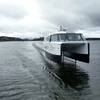The years just prior to the early 1980s collapse in the Gulf of Mexico oil industry saw the building of a large number of crew boats in the 110-ft. range. While a number of these boats remain in the Gulf, many have found their way to other coasts and other applications.
In Charleston, S.C., Stuart Reeves has converted two of the vintage vessels to "head boats" to take groups of sport fishermen out into the Atlantic Ocean for 11-hour trips. The converted boats are certified for up to 154 passengers at distances more than 100 miles offshore.
"These boats are well suited to the conversion," Reeves explains, "They are good sea boats with a low centre of gravity and they are already certified for passengers. Because they were built as work boats they are heavier construction than some head boats built on a pleasure boat hull."
But the conversion leads to a shift in a vessel's power-to-weight ratio. Reeves' company, Starfleet Marine Transport, also serves the oil industry with a fleet of five 125 and 150-ft. crew boats out of Theriot, La. When he converted a 1980-built 110-ft. vessel to a head boat in 1995, he had the work done at Superior Shipyards in Golden Meadow, La.
"We added about 42,000 pounds of aluminum, seating and additional facilities," he says, "As a result the boat was underrated and lost two or three knots off its former 21-knot speed. "
The boat's existing power was three 600 hp two-cycle V-12 engines. Reeves is now replacing these with three of Cummins electronic six-cylinder QSK19 engines rated at 760 hp each for a combined 2,280 hp.
"With these engines we will also significantly increase our torque at the shaft," Reeves explains, "Because they are a longer stroke inline engine than the V-configured engines that we are taking out, we have matched them to ZF IRM350a gears with a down angle of about seven degrees to lower the front of the engine."
While the conversion to head boat cost the boat two or three knots of speed, Reeves is hoping to gain as much as five knots with the increased power and torque. For owners of converted oil field boats that have found new homes in every corner of the marine world, this will be a project worth following.
Featured videos

Inmarsat Enhances Service to Drive Digitalization

Tracking Foreign Vessels Working in the U.S. Jones Act Market

Inside the Electrified Truckable Tug
Subscribe for
Maritime Reporter E-News
Maritime Reporter E-News is the maritime industry's largest circulation and most authoritative ENews Service, delivered to your Email five times per week









